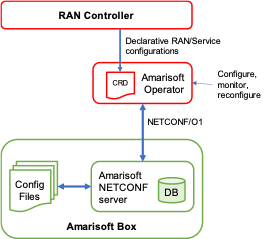
Keep up to date with our innovative initiatives.
Sign up here
Closed loops are key enablers for automation, enabling zero-touch management of RAN components to minimize human intervention. Operations such as self-monitoring, self-evaluation and self-healing are mandatory to simplify the operation of highly complex systems such as 5G networks. In industrial environments, once the network has been deployed, minimizing the impact of day-2 operations (e.g., maintaining, monitoring, and optimizing) is key to ensure service availability and reduce operational costs. To this end, 6GSMART-EZ proposes a solution aiming at automating RAN reconfigurations by adopting the operator framework defined by Kubernetes (K8s) for cloud-native applications.
The operator framework is based on using Custom Resource Definitions (CDRs) in K8s to specify the desired state of an infrastructure resource, e.g. number of containers for a given service. Thus, K8s implements a series of controllers that check the definitions in the CDR against the actual state of the infrastructure, and proactively resolve any conflict, e.g. instantiating a new pod if needed. This allows the implementation of declarative and autonomous reconciliation approaches.
In 6GSMART-EZ, we have adopted this approach to manage desired configuration of the RAN infrastructure. Through the RAN operator, we built a configuration system such as that depicted in the figure below, where the operator defines the desired configuration state using a YAML file, which is then used as ground truth for the system. Upon reboots, unintended manual configurations, or power outages, the 6GSMART-EZ configuration system will ensure that the RAN resource is reverted to the intended configuration without requiring any manual intervention from the network operator.

We have started integrating this solution with our RAN Controller, which allows the remote management of Amarisoft-based RANs through a NETCONF/O1 interface. The next figure illustrates the integration of K8S operators and the RAN Controller, where the Amarisoft Operator is now in charge of configuring, monitoring and reconfiguring the Amarisoft boxes according to the service definition stored in the CDR.

Author: Miguel Catalan-Cid, PhD – Senior Researcher of the Mobile Wireless Internet (MWI) research area at the i2CAT Foundation